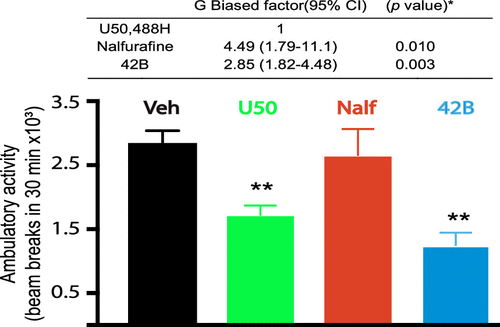当前位置:
X-MOL 学术
›
ACS Chem. Neurosci.
›
论文详情
Our official English website, www.x-mol.net, welcomes your
feedback! (Note: you will need to create a separate account there.)
Comparison of Pharmacological Properties between the Kappa Opioid Receptor Agonist Nalfurafine and 42B, Its 3-Dehydroxy Analogue: Disconnect between in Vitro Agonist Bias and in Vivo Pharmacological Effects.
ACS Chemical Neuroscience ( IF 4.1 ) Pub Date : 2020-09-08 , DOI: 10.1021/acschemneuro.0c00407 Danni Cao 1, 2 , Peng Huang 1 , Yi-Ting Chiu 1 , Chongguang Chen 1 , Huiqun Wang 3 , Mengchu Li 3 , Yi Zheng 3 , Frederick J Ehlert 4 , Yan Zhang 3 , Lee-Yuan Liu-Chen 1
ACS Chemical Neuroscience ( IF 4.1 ) Pub Date : 2020-09-08 , DOI: 10.1021/acschemneuro.0c00407 Danni Cao 1, 2 , Peng Huang 1 , Yi-Ting Chiu 1 , Chongguang Chen 1 , Huiqun Wang 3 , Mengchu Li 3 , Yi Zheng 3 , Frederick J Ehlert 4 , Yan Zhang 3 , Lee-Yuan Liu-Chen 1
Affiliation

|
Nalfurafine, a moderately selective kappa opioid receptor (KOR) agonist, is used in Japan for treatment of itch without causing dysphoria or psychotomimesis. Here we characterized the pharmacology of compound 42B, a 3-dehydroxy analogue of nalfurafine and compared with that of nalfurafine. Nalfurafine and 42B acted as full KOR agonists and partial μ opioid receptor (MOR) agonists, but 42B showed much lower potency for both receptors and lower KOR/MOR selectivity, different from previous reports. Molecular modeling revealed that water-mediated hydrogen-bond formation between 3-OH of nalfurafine and KOR accounted for its higher KOR potency than 42B. The higher potency of both at KOR over MOR may be due to hydrogen-bond formation between nonconserved Y7.35 of KOR and their carbonyl groups. Both showed modest G protein signaling biases. In mice, like nalfurafine, 42B produced antinociceptive and antiscratch effects and did not cause conditioned place aversion (CPA) in the effective dose ranges. Unlike nalfurafine, 42B caused motor incoordination and hypolocomotion. As both agonists showed G protein biases, yet produced different effects on locomotor activity and motor incoordination, the findings and those in the literature suggest caution in correlating in vitro biochemical data with in vivo behavior effects. The factors contributing to the disconnect, including pharmacodynamic and pharmacokinetic issues, are discussed. In addition, our results suggest that among the KOR-induced adverse behaviors, CPA can be separated from motor incoordination and hypolocomotion.
中文翻译:

Kappa 阿片受体激动剂纳夫拉芬与其 3-脱羟基类似物 42B 之间的药理特性比较:体外激动剂偏倚和体内药理作用之间的联系。
Nalfurafine 是一种中等选择性的 kappa 阿片受体 (KOR) 激动剂,在日本用于治疗瘙痒,不会引起烦躁或拟精神病。在这里,我们对化合物 42B 的药理学进行了表征,化合物 42B 是一种 3-脱羟基类似物,纳夫拉芬,并与纳夫拉芬进行了比较。Nalfurafine 和 42B 作为全 KOR 激动剂和部分 μ 阿片受体 (MOR) 激动剂,但 42B 对这两种受体的效力和 KOR/MOR 选择性低得多,这与之前的报道不同。分子模型显示,纳夫拉芬的 3-OH 和 KOR 之间水介导的氢键形成解释了其比 42B 更高的 KOR 效力。两者在 KOR 的效力高于 MOR 可能是由于非保守 Y 7.35之间的氢键形成KOR 和它们的羰基。两者都显示出适度的 G 蛋白信号偏差。在小鼠中,与 nalfurafine 一样,42B 在有效剂量范围内产生镇痛和抗刮擦作用,并且不会引起条件性位置厌恶 (CPA)。与纳呋芬不同,42B 引起运动不协调和运动迟缓。由于两种激动剂均显示 G 蛋白偏倚,但对运动活动和运动不协调产生不同的影响,因此研究结果和文献中的结果表明,在将体外生化数据与体内相关联时要谨慎行为影响。讨论了导致脱节的因素,包括药效学和药代动力学问题。此外,我们的研究结果表明,在 KOR 引起的不良行为中,CPA 可以与运动不协调和低速运动分开。
更新日期:2020-10-07
中文翻译:

Kappa 阿片受体激动剂纳夫拉芬与其 3-脱羟基类似物 42B 之间的药理特性比较:体外激动剂偏倚和体内药理作用之间的联系。
Nalfurafine 是一种中等选择性的 kappa 阿片受体 (KOR) 激动剂,在日本用于治疗瘙痒,不会引起烦躁或拟精神病。在这里,我们对化合物 42B 的药理学进行了表征,化合物 42B 是一种 3-脱羟基类似物,纳夫拉芬,并与纳夫拉芬进行了比较。Nalfurafine 和 42B 作为全 KOR 激动剂和部分 μ 阿片受体 (MOR) 激动剂,但 42B 对这两种受体的效力和 KOR/MOR 选择性低得多,这与之前的报道不同。分子模型显示,纳夫拉芬的 3-OH 和 KOR 之间水介导的氢键形成解释了其比 42B 更高的 KOR 效力。两者在 KOR 的效力高于 MOR 可能是由于非保守 Y 7.35之间的氢键形成KOR 和它们的羰基。两者都显示出适度的 G 蛋白信号偏差。在小鼠中,与 nalfurafine 一样,42B 在有效剂量范围内产生镇痛和抗刮擦作用,并且不会引起条件性位置厌恶 (CPA)。与纳呋芬不同,42B 引起运动不协调和运动迟缓。由于两种激动剂均显示 G 蛋白偏倚,但对运动活动和运动不协调产生不同的影响,因此研究结果和文献中的结果表明,在将体外生化数据与体内相关联时要谨慎行为影响。讨论了导致脱节的因素,包括药效学和药代动力学问题。此外,我们的研究结果表明,在 KOR 引起的不良行为中,CPA 可以与运动不协调和低速运动分开。











































 京公网安备 11010802027423号
京公网安备 11010802027423号